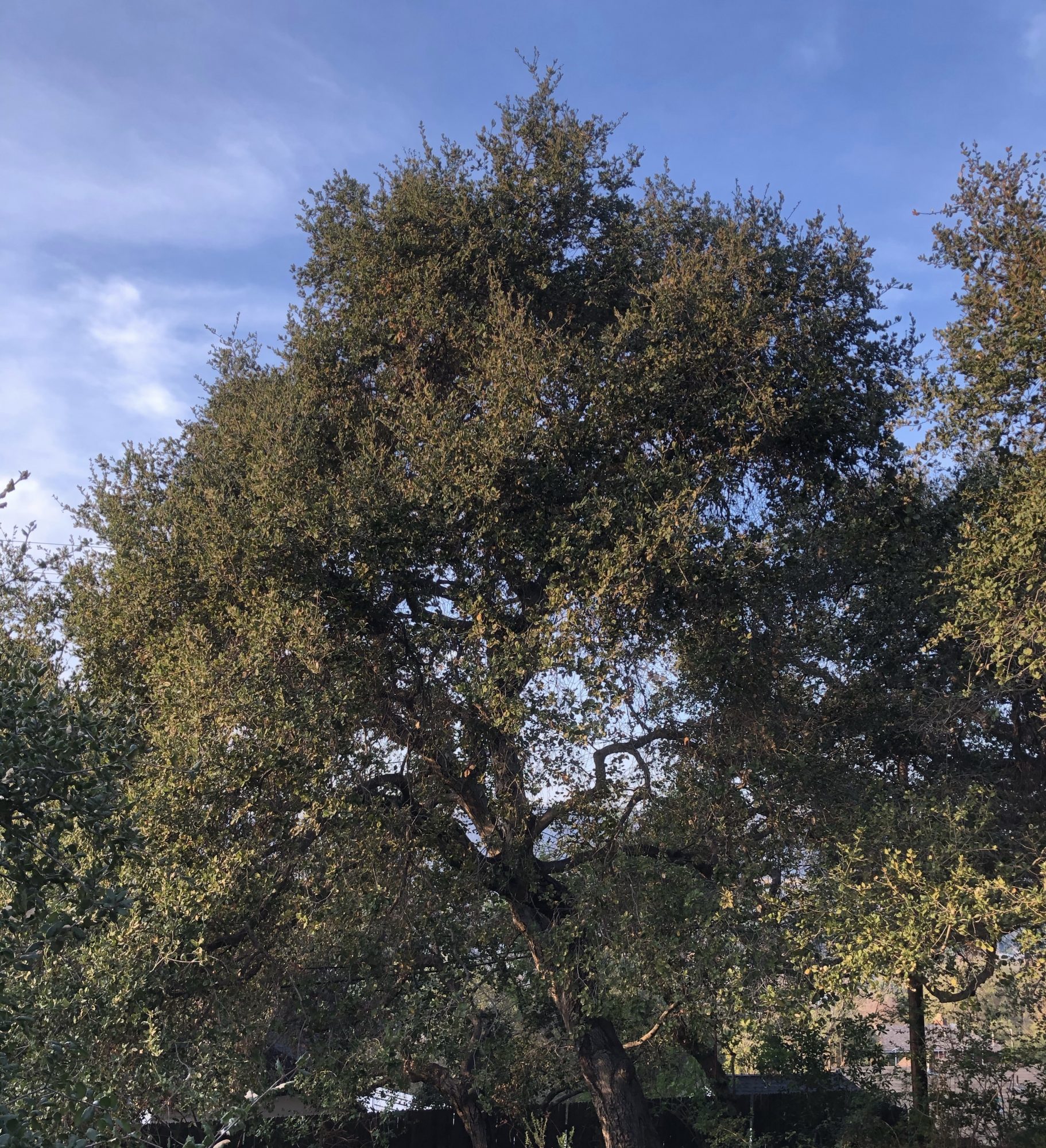The once open hills that stood ready to receive the blessing of winter storms have long since been covered by acres of impermeable paving and artificially irrigated lawns, disrupting the ancient cycle of drought and rain with which these trees have co-evolved over eons. In the not-so-distant past, many of them were bulldozed by developers. The survivors, now at least nominally protected by an ordinance in Los Angeles County, have since had to withstand all manner of misunderstanding or mistreatment, from sprinklers to leaf-blowers to global climate change. And yet, somehow, they manage to persist, peeking over a rooftop here; rising from the middle of lawn there, stoic reminders of a vanished time.
Oak Woke
In the foothill neighborhoods of northeastern Los Angeles County, many gardens are graced by a mature specimen of native Coast Live Oak (Quercus agrifolia), whose presence likely precedes the building of their homes by many decades, if not centuries. These trees bear witness to an astonishing (and unfortunate) transformation of the natural landscape that defines our Anthropocene Era, in which constantly multiplying human interventions have literally reshaped the environmental history of our planet.

A Coast Live Oak (Quercus agrifolia) in the LANPS garden
As a habitat gardener, there is very little you can do that will have a more positive impact on wildlife than preserving and promoting the health of a mature Coast Live Oak
It is my belief that those of us who are fortunate enough to live on a property that includes one of these venerable, remnant oaks has an obligation to assume the role of guardian as a kind of sacred trust, and do whatever we can to protect them in their altered world. If your gardening activities are calibrated to support local wildlife, there is very little you can do that will have a more positive impact on wildlife than preserving and promoting the health of a mature Coast Live Oak, each one of which attracts and supports a vast web of living things.
The following list of the“Do’s & Dont’s” of caring for an established Coast Live Oak is drawn from many resources, including the California Wildlife Foundation’s “California Oaks Project,” local consulting arborist Jan Scow and the writing of the late Bert Wilson of Las Pilitas Nursery. My own experience as a temporary* guardian of several mature oaks in the LANPS garden for almost 30 years has put them all to the test.
* “Temporary,” because if you are a successful oak guardian, the tree will likely outlive you by at least a hundred years.
DO’S
- Do keep soil or other debris from piling up against the base of the oak’s trunk in order to preserve air circulation and discourage damp conditions that can lead to fungal infestation and rot.
- Do keep a thick layer of dead oak leaves on the ground as mulch within the tree’s canopy. This “duff” feeds the tree (as the leaves break down), protects the soil, regulates its temperature and helps control weeds. Put that rake away!
- Do plant appropriate companion plants in the oak understory (see “Oak Companions,” below). We disagree that a managed oak understory should be a sterile, plant-free zone.
- Do water under your oak with an oscillating sprinkler to mimic rain whenever there is less than two inches of actual rain in any given month during the “rainy season,” October-March. Water on a cool day, long enough to simulate approximately two inches of precipitation. In my experience using irrigation “catch cups,” one hour of typical sprinkling equals about one inch of moisture.
- Do keep weeds under control within the oak canopy. Oaks’ feeder roots are actually quite shallow and exotic annual grasses and other weeds will compete with the oak for moisture and nutrients.
- Do consider removing turf and/or any non-native plants that fall within the oak’s drip line, especially those that require supplemental irrigation in summer.
- Do remove any unnecessary impermeable paving anywhere within the oak’s drip line.
DONT’S
- Don’t water under your oaks’ canopy from April through September. It’s okay to “spot” water new, localized plantings that have yet to be established.
- Don’t plant non-native plants within the oak’s drip line.
- Don’t dig or trench anywhere within the oak’s canopy. If you must dig, stay as far away from the base of the trunk as possible.
- Don’t do any trimming of live tissue until the oak is dormant in summer. July and August are the best months for this. In general, trimming of major branches should only be done when absolutely necessary. While it is not strictly necessary to do so, dead twigs and branches may be trimmed at any time.
- Don’t apply fertilizer within the oak canopy
- Don’t import or store mulch or firewood on your property that didn’t originate there: it may harbor dangerous pests or pathogens.
See “Tomorrow’s Oaks Today” on the LANPS Planting Instructions page for a guide to successfully planting and caring for a seedling oak
OAK COMPANIONS
The following is a list of plants that, based on personal experience, will happily coexist with your mature Coast Live Oak and thrive under its canopy (i.e., in dappled shade and with little to no supplemental irrigation required once established). With the exception of Ribes viburnifolium (Catalina Currant), which is endemic to Santa Catalina Island, the plants on this list are all native to the Los Angeles area. (An asterisk indicates a plant that we often propagate at LA Native Plant Source.)
Amorpha californica (California False Indigo)
Claytonia perfoliata (Miner’s Lettuce)
Dichelostema captatum (Blue Dicks)
Dryopteris arguta (Coastal Wood Fern)
Elymus condensatus (Giant Wildrye)
Heteromeles arbutifolium (Toyon*)
Keckiela cordifolia (Climbing Pentstemon*)
Lepechinia fragrans (Fragrant Pitcher Sage)
Lilium humboldtii ssp. ocellatum (Spotted Humboldt Lily*)
Lonicera subspicata var. denudata (Santa Barbara Honeysuckle*)
Melica imperfecta (Small Flowered Melica)
Polypodium californicum (California Polypody)
Prunus ilicifolia (Hollyleaf Cherry)
Frangula californica (Coffeberry)
Rhamnus ilicifolia (Hollyleaf Redberry*)
Ribes amarum (Bitter Gooseberry*)
Ribes aureum var. gracillimum (Golden Currant)
Ribes malvaceum (Chaparral Currant)
Ribes speciosum (Fuchsiaflower Gooseberry*)
Ribes viburnifolium (Catalina Currant)
Salvia spathacea (Hummingbird Sage)
Sambucus nigra ssp. caerulea (Blue Elderberry*)
Solanum xanti (Purple Nightshade)
Symphoricarpos mollis (Creeping Snowberry)
Toxicodendron diversilobum (Poison Oak*)
Umbellularia californica (California Laurel)
Venegasia carpesioides (Canyon Sunflower)
– Eric Ameria
© 2021 by LA Native Plant Source

